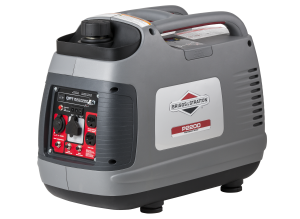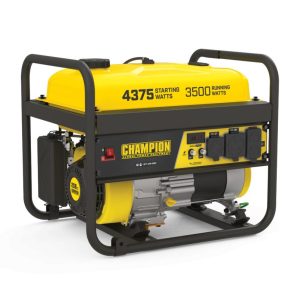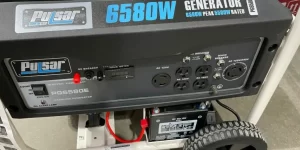SOLVED: Why Does Your Honda Generator Start Then Die?
You were ready for the next power outage because you had a generator on hand. However, you were not expecting it to stop running once it was started.
A plugged air filter, incorrect choke setting, clogged fuel line, plugged fuel filter, dirty carburetor, bad gas cap, dirty spark plug, faulty ignition coil, low engine oil level, or old gasoline can cause a Honda generator to start and then die.
Follow all of the safety precautions outlined in the Honda owner’s manual. Before performing repairs, remove the spark plug wire and allow the engine to cool.
Before diagnosing, repairing, or operating your equipment, read and follow all safety instructions in the operator’s manual. Consult a professional if you lack the necessary skills or knowledge, or if you are unable to perform the repair safely.
Table of Contents
11 Reasons a Honda Generator Starts Then Dies
Gas Tank is Empty on a Honda Generator
When your Honda generator stops working, the first thing to check is the gas tank. I know this seems obvious, but it is sometimes overlooked when an owner is frustrated and attempting to restart the generator.
SOLUTION: If the tank is empty or low on fuel, refuel it.
Old Fuel in a Honda Generator
Even if you have enough gas in your generator to run it, you may have old gas that causes it to run slowly and eventually die. This is due to the fact that old gas leaves behind varnish and sticky deposits, which clog fuel components and cause fuel restrictions.
The engine will not run if there is insufficient gas. Because gas can begin to degrade as soon as 30 days after purchase, it’s critical to buy new gas and use it within 30 days.
It’s much easier said than done. You never know when you’ll need the generator or how long you’ll need it to run.
I recommend adding Sea Foam Motor Treatment to each fuel tank to stabilize the gas and reduce moisture buildup, allowing the fuel to last a little longer before it breaks down.
Follow these tips to get the best fuel results:
- Unleaded gasoline with a minimum octane rating of 87 and a maximum ethanol content of 10% is required for 4-cycle Honda generators.
- Avoid using gasoline with a higher ethanol content.
- Gas should be used within 30 days.
- Never leave gas outside or in places where it can attract moisture.
- Keep gas in a cool, dry place.
- Purchase only enough gas to last 30 days. If you buy more than this, add a fuel stabilizer to the gas.
SOLUTION: Drain old gas into a container to be properly disposed of. To stabilize and clean the fuel system, add fresh fuel with a fuel additive.
Plugged Fuel Filter on a Honda Generator
An inline fuel filter is installed between the fuel lines to strain the fuel before it enters the carburetor and engine. The filter’s purpose is to prevent dirt and debris from damaging the engine.
When the filter isn’t replaced on a regular basis, dirt can accumulate and prevent fuel from flowing through it. The engine may die as a result of a lack of fuel.
SOLUTION: Change the dirty fuel filter.
Fuel Line Blockage on a Honda Generator
A clogged fuel line is another factor that can limit fuel flow. Stop and restart the fuel flow while checking the flow coming from each section of the fuel line to find a clog.
When evaluating fuel flow, allowing fuel to flow into a container works best. Because fuel cannot run uphill without the assistance of a pump, make sure the container is placed lower than the fuel tank.
SOLUTION: Turn off the fuel supply, disconnect the fuel line from the generator, and spray carburetor cleaner into the line to help loosen the clog. Then, using compressed air, blow air through the line until the clog is removed.
Replace the line. If you are unable to remove the clog or discover that your fuel lines are dry and cracked, you can easily replace them with a new fuel line purchased at your local hardware store.
Dirty Carburetor on a Honda Generator
The carburetor is frequently the cause of a Honda generator starting and then dying. As previously stated, old fuel can leave deposits. Deposits can clog the fuel jet and stick internal carburetor parts.
When this happens, the carburetor can no longer deliver fuel to the engine, causing it to continue to run.
SOLUTION: Disassemble and remove the Honda carburetor. Taking photos along the way helps me reassemble it.
Clean it to remove gummy deposits and crusty buildups left over from using old fuel and ethanol-based fuels. You may need to rebuild or replace your carburetor if it is excessively dirty or has broken components.
Clogged Air Filter on a Honda Generator
The air filter prevents dirt from entering the engine through the air intake. To avoid engine damage, always run the generator with an air filter.
Not only should you always use a filter, but you should also keep it clean so that it does not limit the amount of air that passes through it. A Honda generator will not start if there is an air restriction.
If you use a generator on a regular basis, I recommend changing the air filter once a year. You should also inspect the condition of the filter before each use and clean or replace it as needed.
I recommend replacing the air filter once a year and cleaning it a few times a year for the average homeowner. When the filter becomes extremely dirty or damaged, it must be replaced.
SOLUTION: If your Honda air filter becomes clogged with dirt, follow the steps below to clean it. If you are using a different type of filter or are unsure of the type of filter installed on your generator, consult the Honda operator’s manual.
Clean a Honda generator foam-style air filter
- Take the air filter out of the housing.
- Remove any remaining dirt from the air filter housing and cover. Allow no dirt to enter the air intake.
- Examine the foam filter for damage and replace it if necessary.
- If the filter is in good condition, rinse it with soapy water until the water runs clear.
- Allow the filter to dry after squeezing it.
- Soak the filter in clean engine oil until it is completely covered. The filter should then be squeezed to remove any excess engine oil. It should not be dripping with oil.
- Replace the air filter.
- Reassemble the air filter cover.
Wrong Choke Setting on a Honda Generator
To restrict air, a Honda generator with a cold engine must be started with the choke closed. Once the engine has warmed up, the choke must be adjusted to the open position to allow more airflow and keep the engine running.
SOLUTION: If your engine starts and then immediately shuts down, make sure the choke is turned off and in the open position. Also, ensure that the choke plate is not stuck and that it opens and closes properly.
Bad Gas Cap / Fuel Tank Vent on a Honda Generator
The fuel tank must be vented to avoid forming a vacuum. On a Honda generator, the fuel tank vent is usually built into the fuel cap.
When the fuel tank cap becomes plugged or damaged, air cannot pass through it. The vacuum that forms in the tank prevents fuel from reaching the carburetor, causing the Honda generator to shut down.
When the generator won’t start until you loosen the fuel cap and allow air into the fuel tank, you’ll know it’s the fuel tank vent. If the generator starts and runs with the fuel cap loosened, try to reproduce the problem by tightening the fuel cap.
Allow the generator to continue running to see if it becomes sluggish and eventually shuts down. If the fuel tank vent shuts down and won’t restart until air is allowed into the tank, you most likely have a problem.
SOLUTION: Replace the gas cap if the fuel tank is not venting properly.
Dirty Spark Plug on a Honda Generator
To start and run a Honda generator, you must have spark. So, if the generator started, you got enough spark to get it going. However, the spark plug may be very dirty or damaged, resulting in intermittent spark and death.
SOLUTION: Remove the spark plug and inspect it. If the tip is very dark in color, the electrode is worn, or the porcelain is broken, the spark plug must be replaced.
If it appears to be in good condition, clean it with a wire brush, check the electrode gap, and secure the spark plug wire. A faulty spark plug gap or a loose wire can also cause the generator to shut down.
Bad Ignition Coil on a Honda Generator
Before looking for a faulty ignition coil, make sure your spark plug is in good working order. The ignition coil supplies voltage to the spark plug, allowing the engine to start.
The engine will not start if the spark plug is unable to fire due to a faulty spark plug or ignition coil.
SOLUTION: Using an ohm meter, check the continuity of the ignition coil. Replace the ignition coil if you find a break in the continuity.
Insufficient Engine Oil Level in a Honda Generator
Your generator may run for a while before abruptly stopping. Check to see if the low engine oil warning light is illuminated. When the oil level in a Honda generator is low, a sensor will shut it down to protect the engine. It will not start again until the engine oil level is adjusted.
It may be aggravating that it will not continue to run. In this case, however, the generator shutting down is a good thing.
Continuing to run a low-oil engine can cause significant engine damage because a lack of lubrication causes friction to build up in the engine. The engine can get so hot that the parts start to melt.
SOLUTION:
Place the generator on a level surface to check the engine oil level. To remove the oil, remove the oil fill cap and wipe the dipstick with a clean cloth.
Replace the dipstick in the oil-fill tube but do not tighten the cap. Take it out and check the oil level on the dipstick. Check that the dipstick is in the middle of the range.
If it is not, adjust the engine oil level by removing or adding a small amount of oil until it is. If you have the correct engine oil level but the low oil sensor remains illuminated, you may have a faulty sensor. It is preferable to take the Honda generator to a service center for repair.







